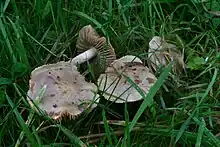| Hebeloma gigaspermum | |
|---|---|
 | |
| Scientific classification | |
| Domain: | Eukaryota |
| Kingdom: | Fungi |
| Division: | Basidiomycota |
| Class: | Agaricomycetes |
| Order: | Agaricales |
| Family: | Hymenogastraceae |
| Genus: | Hebeloma |
| Species: | H. gigaspermum |
| Binomial name | |
| Hebeloma gigaspermum Gröger & Zschiesch. | |
| Hebeloma gigaspermum | |
|---|---|
| Gills on hymenium | |
| Cap is convex | |
| Hymenium is emarginate | |
| Stipe is bare | |
| Spore print is brown | |
| Ecology is mycorrhizal | |
| Edibility is unknown | |
Hebeloma gigaspermum is a European species of mushroom in the family Hymenogastraceae.
Taxonomy
The species Hebeloma gigaspermum was first described only in 1981[1] and is externally similar to the much better-known Hebeloma sacchariolens (being placed in subsection Sacchariolentia of the genus). It is not uncommon in Northern Europe and until 1981 examples were probably simply considered to be H. sacchariolens.[2]
The name gigaspermum means "giant-spored".
Description
It is a nondescript clay brown or ochre mushroom with somewhat viscid cap, up to about 5 centimetres (2 inches) in diameter, and has a strong sweet odour which has been likened to orange blossom or amyl acetate.[3]
Similar species
It is similar to H. sacchariolens, and according to one source can be distinguished by
- its ecology with willow and alder in boggy ground (as opposed to forests and gardens with broad-leaved trees in general), and
- its large spore size of 13–17 × 7–9 μm (as opposed to 11–14 × 6–8 μm).[2]
As Hebeloma contains poisonous species, H. sacchariolens is not to be recommended for culinary use.
References
- ↑ Gröger F, Zschieschang G. (1981). "Hebeloma-Arten mit sacchariolens-Geruch". Zeitschrift für Mykologie (in German). 47: 195–210.
- 1 2 Knudsen, Henning; Jan Vesterhout (2008). Funga Nordica. Copenhagen: Nordsvamp. p. 816.
- ↑ Bon M. The Mushrooms and Toadstools of Britain and North-Western Europe. Hodder & Stoughton. ISBN 0-340-39935-X.. Bon does not include H. gigaspermum but gives details of H. sacchariolens, especially the smell.